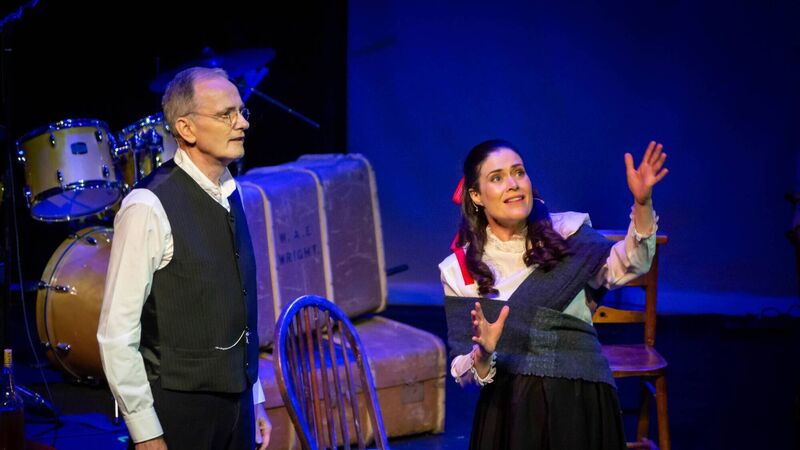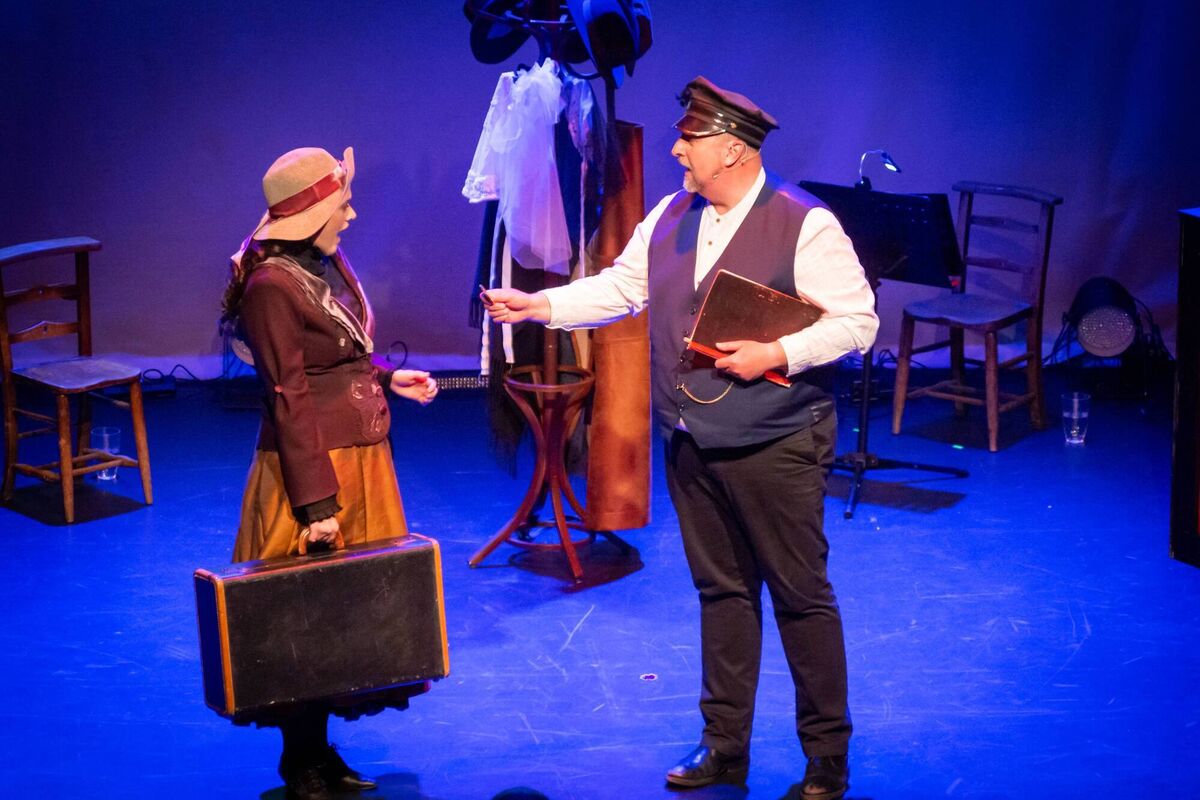Man related to Cork's Annie Moore writes musical about lives of immigrant women

"Annie Moore - First Immigrant", will be performed at The Everyman on April 2.
A MUSICAL about Cork woman Annie Moore, the first Irish immigrant to the U.S to pass through federal immigrant inspection at Ellis Island in New York, in 1892, has been devised and composed by Inniscara-reared Paul Linehan.
Paul, a primary school teacher in Kildare, says his cast is very excited about bringing the show to the Everyman on April 2.
Entitled Annie Moore – First Immigrant, the show tells the story, at times imagined, of Annie, who is an ancestor of Paul. She is his first cousin, three generations back.

Explaining how this relationship came to light, Paul, an opera singer for 30 years, says that back in 2016, Cork city-based genealogist Tim McCoy was in contact with American genealogist Megan Smolenyak, who discovered Barack Obama’s Irish roots in Co Offaly. Megan felt that there were a lot of inaccuracies concerning Annie Moore and there was even ‘the wrong Annie Moore’.
“Megan thought there had to be ‘a correct Annie Moore’ and came as far as Cork to find out. Tim and Megan managed to track down a cousin of my mother, Tom Long, and that was the origin of it. Once it was established that they were looking into the original Annie Moore, we were delighted to know there was a family connection.”
Annie, who was born in 1874 and died 100 years ago next year, in 1924, lived in Rowland’s Lane in the shadow of the Shandon Bells. Her parents and two of her siblings had gone to America four years before she left for the land of promise.
“Annie was left with an uncle, an aunt and her two younger brothers, Anthony and Philip. Presumably, her parents went to New York to set up a life there and earn the fare to send back to their other children so they could travel to them. Even the age Annie was when she went to America is subject to debate. Some say she was 15 but we reckon she was 17 when she left Cork.”
There isn’t much in the way of records about Annie.
“Her moment of glory was being first through Ellis Island. Once she stepped away from it, she lived a very ordinary life of an immigrant in New York. The historical markers, such as births, deaths and marriage certificates attached to her life indicate she had ten or possibly 11 children, five of whom died before the age of three.
"So it’s a tragic story in that sense, but typical enough, on the other hand, for an immigrant struggling from hand to mouth.”

Annie married a man of German descent called Gus Schayer. Paul plays Gus in the show.
“He was second generation German and said to be of a gentle disposition. His father had a bakery but Gus spent a lot of time working in the Fulton Fish Market in New York as a salesman. It wouldn’t have been common for the Irish and Germans to come together. They were probably living in close proximity so, at a guess, it was probably a romantic marriage rather than an arranged one. Annie lived in Cherry Street at first and had several moves, all within a 2km radius of where she landed.”
Paul says Annie would have most likely moved from a tenement in Cork to one in New York that wasn’t much better.
“There was the same poverty, the same hardships and struggle to make ends meet. She had a tough life with the loss of five of her children. She died young at 50 of heart failure. She was very heavy. There was a story that when she died, she was too large to be taken out the door so they had to bring her out through a window. It was the final indignity of her life. Gus outlived her by 30 years.”
In a census form, Annie stated that she was able to read and write. “You could maybe take that with a grain of salt. That wouldn’t have been typical of the time.”

For his research, Paul read City Of Dreams by Tyler Anbinder. This “is very good on New York through the ages. It illustrates the various immigrant communities and the lives they were living.
“The Irish did not have a very good name in New York at the turn of the 20th century. They were not welcome in a lot of places, with signs saying ‘no blacks, no Irish’. The Irish servant girls were caricatured as having ape-like faces. It was very different to how welcome the Irish are now in America.
“At the time, the Irish were seen as yet another group trying to better themselves by standing at the shoulders of others.”
While poverty was rife among the Irish in New York, Paul says there were opportunities.
“In New York at the turn of the 20th century, there was a huge needlework industry so that Irish women would have got employment there.”
It’s not known what Annie worked at when she arrived in New York, but Paul has assumed she worked as a servant.
The musical includes ten new original songs. It explores the plight of women at the time with themes such as infant mortality, prejudice, alcohol and sobriety, all helping to “create a factual account of life in America for an Irish immigrant”.
Paul adds: “The songs provide an insight into the political and societal norms of the period, while holding a mirror to more recent events worldwide and encouraging us to reflect on our attitudes towards immigrants in Ireland.”
As Paul points out, the endgame for the likes of Annie was her legacy in the form of her surviving children “who were the ones who’d receive education, health care, better nutrition and access to a better life.”

But Annie Moore’s life, which was so full of hope when she departed Cobh for America with her two younger brothers, was hard.
The musical is in two halves, with the first act being an American wake, which was both a celebration of Annie’s forthcoming adventures as well as a poignant marker that she’d most likely never again return to the land of her birth.
The statues sculpted by Jeanne Rynhart, one standing near Cobh Heritage Centre depicting Annie and her two brothers, and the other erected in Ellis Island, represent the millions who passed through Ellis Island in pursuit of the American dream.
“The female voice of the diaspora of the time went almost unheard. This show highlights the challenges that Annie and all the other ‘Annies’ faced, and indeed continue to face, as both immigrants and women.”
Annie’s life also inspired the song, Isle Of Hope, Isle Of Tears, which was written by Brendan Graham after he visited Ellis Island. The song has been performed by Ronan Tynan, The Irish Tenors, Sean Keane, Dolores Keane, Daniel O’Donnell, and others.
Things named in honour of Annie Moore include the Annie Moore Award, presented annually by the Irish American Cultural Institute. There is also a utility vessel operated for the National Park Service, and a software programme developed at Worcester Polytechnic Institute in Massachusetts, Lund University in Sweden and the University of Oxford in England, which uses a ‘matching algorithm’ to allocate refugees with no ties to the host country to their new homes.
Annie Moore may have led an ordinary and somewhat tragic life after her auspicious entry to America, but she has been immortalised. No small feat for a girl from Shandon.






 App?
App?





